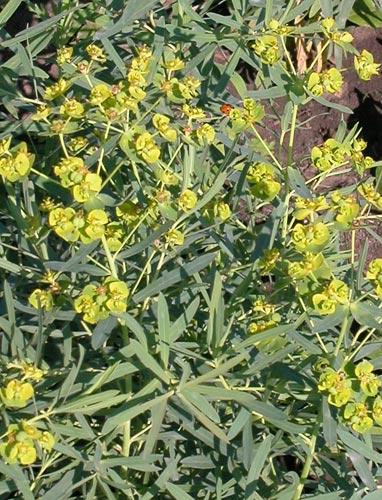Weeds
Euphorbia virgata Waldst. & Kit. - Rod Spurge
Systematic position.
Family Euphorbiaceae, genus Euphorbia L. (Tithymalus Gaertn.).Synonyms.
E. boissieriana (Woronow) Prokh., E. kitaibelii Klock. & Dubovik, nom invalid., E. waldsteini (Sojak) Czer., E. waldsteini (Sojak) A.Radcliffe-Smith, comb. superfl., Tithymalus virgatus (W. et K.) et Gke. ex Garke, Tithymalus graminifolius (Vill.) Sojak subsp. waldsteinii (Sojak) Sojak, Tithymalus tommasinianus (Bertol.) Sojak subsp. waldsteinii (Sojak) Sojak, Tithymalus waldsteinii Sojak.Biological group.
Perennial plant that forms offshoots.Morphology and biology.
It is a perennial glabrous glaucous plant. All parts of the plant contain a milky juice. Root system is well developed. It consists of a main ligneous root, which can reach a depth of 4 m or more. The root branches at a depth of 5 to 25 cm. Root offshoots can develop on all parts of the root system. Stems are 25-80 (100) cm tall, upright, few in number, with lateral vegetative shoots. 5-20 flower-bearing shoots grow from axils in the upper part of the stalk. 3-7 vegetative fruitless branches are located below and are 3-7 cm long. Phyllotaxy is alternate. Leaves soft, falling, without stipules. Stem leaves shortly petiolar or almost sessile, spirally arranged, entire, glabrous, 2-10 mm wide, 2 to 9 cm long, narrowing base. Leaves linear or lanceolate, with the greatest width in the lower half, pointed, rather dense, mat, with lateral ribs arising from main rib at angle 15-30°C. Leaves on vegetative branches are narrowly linear, 1.5-3.5 cm long, 1-4 mm wide, sharp or pointed. Top peduncles are aggregated in "umbellate" inflorescence in groups of 5-20 (often 8). Flowers fine, inconspicuous, unisexual and greenish-yellow. They are also aggregated in complex inflorescence. The latter includes some male flowers consisting of single stamen and one female flower with an ovary. Pistillate female flower and staminate male flowers are wrapped in a cup-shaped bract with lobes and glands (nectaries). Involucral leaflets and upper leaves under peduncles are green, sessile, with rounded base, 7-30 mm long, 2-12 mm wide, pointed or sharp; elliptic, oblong or ovoid in shape. The flowers are inserted among pairs of round floral bracts. Bracts are 5-12 mm long, 5-20 mm wide, wider than long, almost blunt, yellowish; reniform or ovoid-triangular in shape. Cup-shaped bract is narrow-campanulate, 2-3 mm long and 2 mm wide, glabrous outside, with ovoid or round ciliate lobes. Nectaries (glands) without appendages, green, later brown, half-lunar. They are extended in the shape of long entire or dentate horns, being sometimes twisted. Columns are 2-3 mm long and accrete by third, deeply bisected. Ovary is 3-celled; each cell with 1 seed. Fruit is ovoid three-nutlet ("three-celled boll"), 3-4 mm long and 4-5 mm thick, deeply three-furrowed, with rounded lobes. Seed about 1.8-2 mm long, usually with appendage at base. Blossoms in June and August, produces fruit in July and September. The plant spreads by seeds and often by underground offshoots.Distribution.
Plant grows in middle Europe, East Mediterranean, Turkey, the Balkans, Asia Minor, Northern Iran, Dzungaria. It was described from Hungary. In the territory of the former USSR the species is distributed in southern and middle areas of the European part and Western Siberia, and in Ciscaucasia. Now it is also sporadically settled in Eastern Siberia, Central Asia, and in the Far East.Ecology.
The species is meadow-steppe, eurytopic, mesophytic, anthropotolerant. It is distributed in forest-steppe and steppe, penetrating into southern part of forest zone. In natural habitats the plant is found along river banks and in bottomlands, on meadows, in steppes, edges, foothills, among bushes, frequently on sandy or limy ground. It is a nitrophyte. Regarding anthropogenous habitats, the plant grows in ruderal and segetal places, i.e., on fallow lands and boundaries, along roadsides and in waste places, less often in fields and in crops. Because of lacteal sap the Euphorbia is not eaten by cattle, therefore it survives well in pastures.Economic significance.
Milky sap of the Rod Spurge can cause severe rashes on human skin. Spurges are generally poisonous to livestock, but sheep apparently eat the spurges without detriment. The weed is poisonous, being also a dye plant. It litters all cultures everywhere, especially grain crops (winter and spring wheat, winter rye, oat). It is found among crops frequently, but is not abundant, at most 2 points according to Maltsev's scale. It is considered a malicious agricultural weed in areas of irrigated agriculture in the European part and Ciscaucasia. Control measures are identical to those for other weeds that form offshoots and are directed at the exhaustion of their root system, i.e., regular eradication of rhizomes of the weed with the help of appropriate types of soil treatment and herbicides; avoiding contamination of sowing material or ground by seeds of the weed; mowing off or pulling up the weed before fructification. An effective measure against the weed is a soil treatment that crumbles and crushes roots the most finely, and digs them in to the ground most deeply. It is necessary to recommend crop rotation, such as fallow - winter-crop - row-crop or perennial grasses.Reference citations:
Keller B.A., Lyubimenko V.N., Maltsev A.I., Fedchenko B.A., Shishkin B.K., Rodzevich R.Yu., Kamenskii K.V., eds. 1934. Weed plants of the USSR. V. 3. Moscow-Leningrad: AS USSR. 448 pp. (In Russian)Nikitin, V.V. 1983. Weed plants of the USSR flora. Leningrad: Nauka. 454 pp. (In Russian)
Shlyakova E.V. 1982. Keys to field weed plants of Non-Chernozem zone. Leningrad: Kolos. 208 pp. (In Russian)
Vasilchenko, I.T. & O.A. Pidotti. 1975. Keys to weed plants of areas of irrigated agriculture. Leningrad: Kolos. 375 pp. (In Russian)


